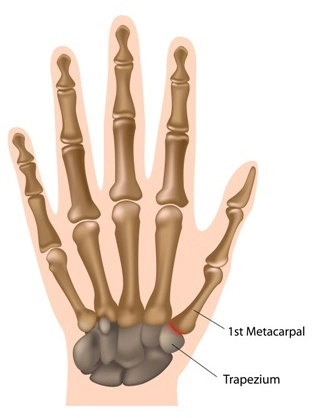Arthritis is a common condition that can occur in any joints in your body, including your thumb.
The condition can cause inflammation and stiffness within a joint, significantly impacting your daily life. Without the proper use of your thumb, simple tasks such as opening a door or twisting the lid off of a jar can become impossible.
Early detection of thumb arthritis is essential because it can mean less invasive treatments are needed. The treatments can also be more successful the less serious the condition is.
Importantly, the right treatment can alleviate the condition and restore your range of movement in the joint. Treatment can include a combination of medication, splints and surgery such as a trapeziectomy. But when is surgery recommended? Learn more with The Horder Centre and discover how we treat thumb arthritis.
Understanding thumb arthritis
Thumb arthritis (also known as basal joint arthritis) affects 20% of people over the age of 55 and occurs at the base of the thumb between the metacarpal and trapezium bones.
It is the second most common type of arthritis that occurs in the hand and is thought to impact women more than men.
What causes thumb arthritis?
Each joint in the body is lined with cartilage to help your bones move without discomfort. However, when this cartilage wears away, it causes inflammation, pain and stiffness within the affected joint.
The causes of thumb arthritis vary from person to person, but the most common cause is ageing. As our bodies age, the cartilage between the joints naturally wears down — leading to arthritis.
Of course, other factors can increase your risk of developing thumb arthritis, such as an injury to your thumb, having pre-existing health conditions such as lupus and rheumatoid arthritis and having a genetic predisposition to the condition.

Signs and symptoms of thumb arthritis
The most common symptoms of thumb arthritis include:
- Pain in your thumb
- Swelling or tenderness at the base
- Aching after using your thumb for a long time
- Reduced range of motion
- Decreased strength when trying to grip with your thumb
In addition, sometimes a bone spur can develop at the base of the thumb, which can feel like a small bump.
These symptoms can have a big impact on your daily life because, without the proper use of your thumb, even something as simple as pouring a kettle or using a smartphone can become difficult.
It can also impact activities such as driving. Being unable to grip the steering wheel properly is dangerous — another reason why early detection and treatment of the condition is essential.
Treatment options for thumb arthritis
There are many different treatment options for thumb arthritis and the right treatment for you will depend on the severity of your condition.
Firstly, you might be recommended certain lifestyle changes and exercises to do to keep the thumb moving. By moving the thumb, you can rebuild strength in the joint and reduce pain, stiffness and inflammation in less severe cases.
Exercises for thumb arthritis can include thumb circles, thumb stretches and practising gripping. Soft braces can help provide extra support and limit the movement of the thumb — allowing it to rest.
Medication
If exercise and lifestyle changes do not help, you may be prescribed pain relief medication.
If the pain isn’t too severe, over-the-counter pain relief such as NSAIDs (nonsteroidal anti-inflammatory drugs) can be enough to alleviate the pain. If over-the-counter medication does not work, then a stronger medication may be prescribed.
Medication can be useful, but many pain relief medications cannot be taken long-term without having unwanted side effects. Even prolonged use of NSAIDs can lead to problems like stomach ulcers.
As arthritis is a degenerative condition, it will need consistent and long-term treatment, something which medication might not provide.
Steroid injection
If the pain of thumb arthritis isn’t responding to medication, then a steroid injection into the thumb may be offered. These provide long-lasting relief but do wear off over time. Plus, you can only have up to four injections in the same area within 12 months. So, if it wears off before then and you cannot have any more injections, this treatment might not be the best long-term solution.
If none of the above treatments work for your thumb arthritis, then surgery will be the next step.
Trapeziectomy procedure: what is it and how does it work?
A trapeziectomy is a surgical treatment for thumb arthritis. It involves the removal of the small trapezium bone in the wrist near the base of your thumb. By removing this bone, your thumb has more space to move which stops your bones from rubbing against each other and causing pain.
Before the procedure begins, the area will be numbed with a regional anaesthetic (which numbs the whole arm) or you will be given a general anaesthetic (which will cause you to fall asleep). A small incision is then made into the base of your thumb and the trapezium bone is removed. Sometimes, the space is filled with a piece of tendon from your wrist.
After the procedure has been completed and the incision sutured (closed), a thick dressing is applied to protect the thumb.
Recovering from a trapeziectomy
After the surgery, it is important to keep the thumb elevated to reduce swelling and keep the fingers and hand moving to stop them from getting stiff.
After two weeks, the stitches can be removed and a light splint provided so you can use the hand that’s been operated on for gentle activities.
At the four-week mark, you will be given exercises to do that will help strengthen your thumb. The splint will need to be worn for six weeks and you will need to avoid driving for at least eight weeks too.
Once the wound is fully healed, you can get the hand wet and moisturise your scar, but it can take up to six months before you can do any heavy lifting.
When you are fully recovered, you should have a much better range of motion in your thumb and a big reduction in pain.
When is a trapeziectomy recommended?
A trapeziectomy is a last-resort treatment and will only be recommended when medications or steroid injections do not provide you with relief and if thumb arthritis is having a big impact on your daily life.
If you find you can no longer work, drive or perform simple tasks like opening doors, and it causes significant pain that cannot be easily managed, then a trapeziectomy may be the best course of treatment.
Recovery takes time, which is why a trapeziectomy is not offered to people with minimal discomfort whose condition can be managed with NSAIDs or other non-surgical treatments.
Prevention and lifestyle changes to help with thumb arthritis
It is not always possible to prevent thumb arthritis, but you can reduce your risk of it developing by:
- Regularly completing hand and thumb exercises to keep the joint strong
- Staying physically active
- Taking precautions when performing tasks that could injure your thumb — this could include strapping your hands when lifting heavy weights
- Quitting smoking — this can reduce the risk of rheumatoid arthritis
- Supporting your wrists, hands, fingers and thumbs if you type a lot — this can be achieved with wrist cushions, correct posture and the right keyboard

Managing the symptoms of thumb arthritis at home
There are some lifestyle changes you can make to effectively manage your symptoms at home — as long as they are not severe.
Lifestyle changes to adopt include:
- Using heat or ice to provide relief from inflammation
- Exercising your hands and thumbs regularly and safely
- Wearing splints or supports when you experience pain or know you are going to be doing an activity that could cause you discomfort
- Avoiding activities that you know cause you pain or reducing the amount of time you spend doing them
- Using adaptive equipment, such as jar openers, electric can openers and foam handles for toothbrushes to help with everyday activities that have become harder due to arthritis
Book a consultation with The Horder Centre
Thumb arthritis is a disruptive, degenerative condition that can impact your everyday life. However, it can sometimes be effectively managed with non-surgical treatments such as NSAIDs and steroid injections. But as the condition becomes worse over time, surgical treatments like a trapeziectomy may be the best solution.
If you are struggling to manage your thumb arthritis, get in touch with The Horder Centre. Our experienced team is here to provide you with the support and treatment you need to manage this complicated condition.
We provide outstanding patient experiences
The Horder Centre is an award-winning Centre of Excellence that offers patients a unique therapeutic environment. Specifically designed for orthopaedic surgery, our facilities include a physiotherapy inpatient gym and courtyard gardens designed by clinical experts to enhance recovery. Finance options available.
Read our patient testimonials
Find out what it’s like to be a patient, from the people who matter the most.





